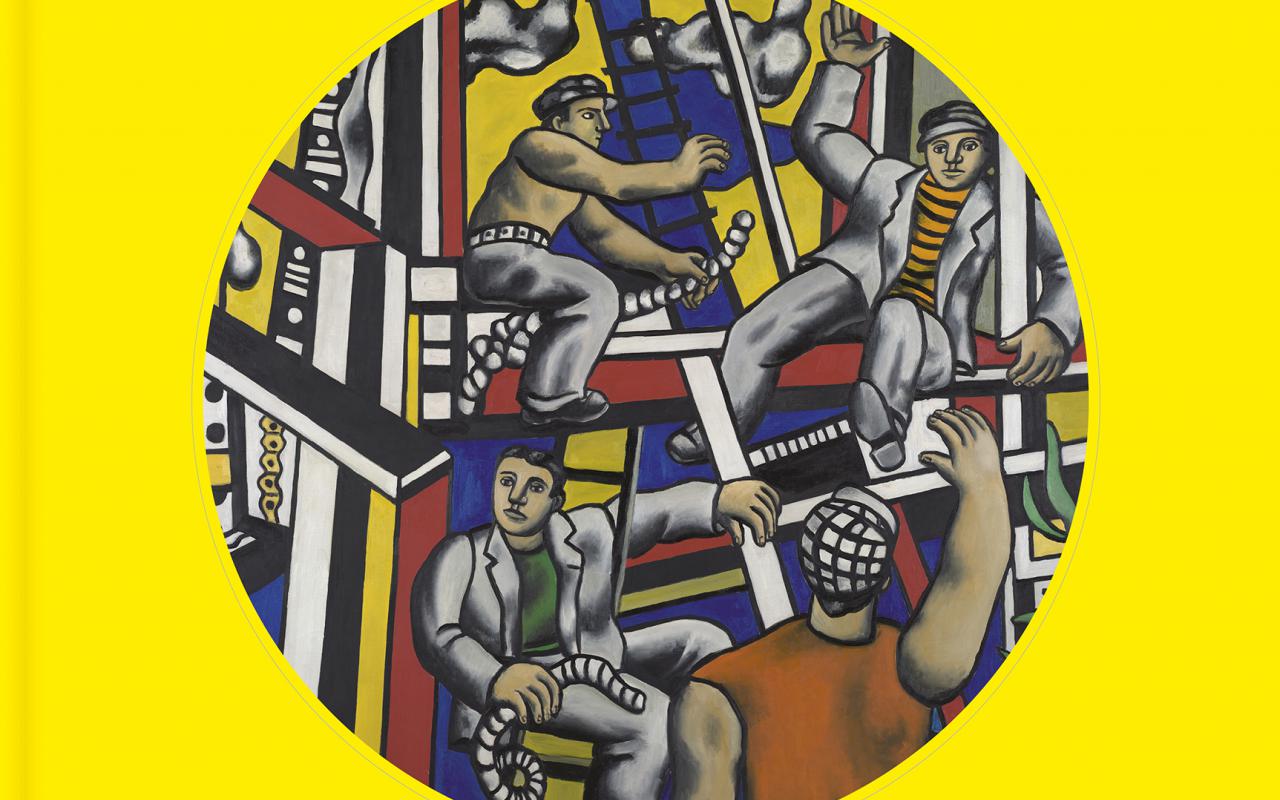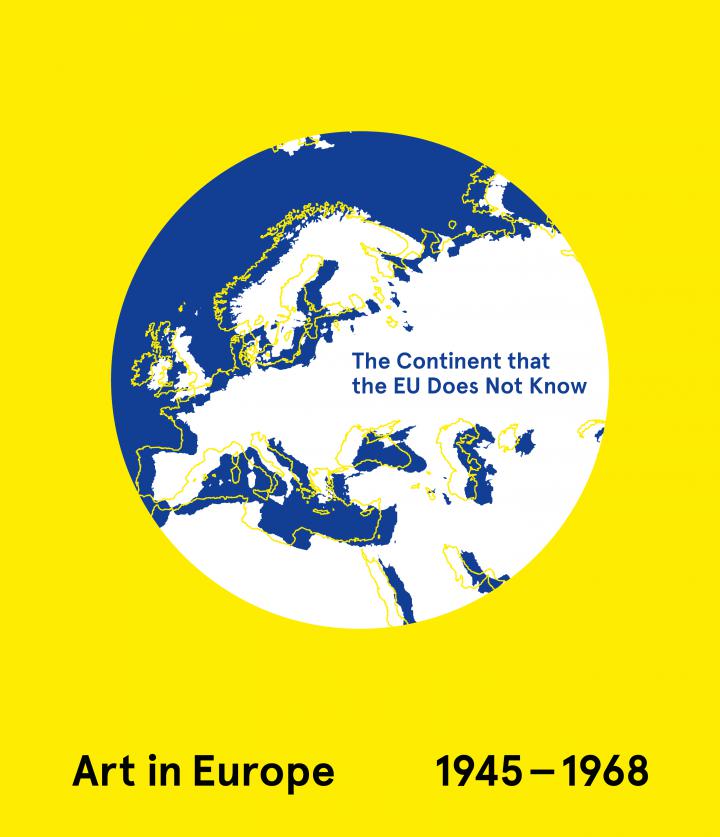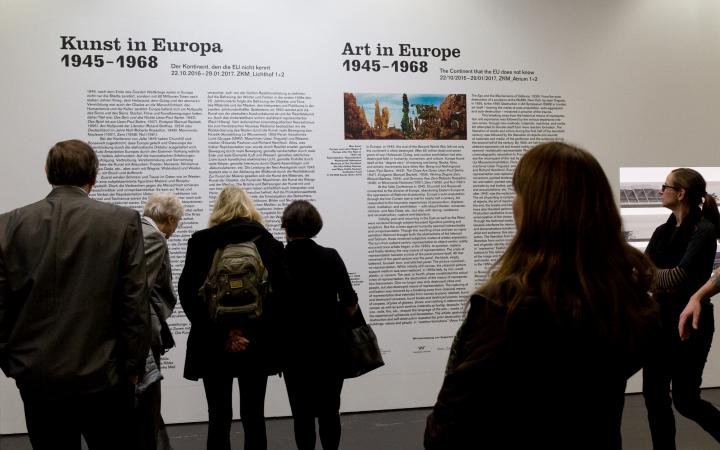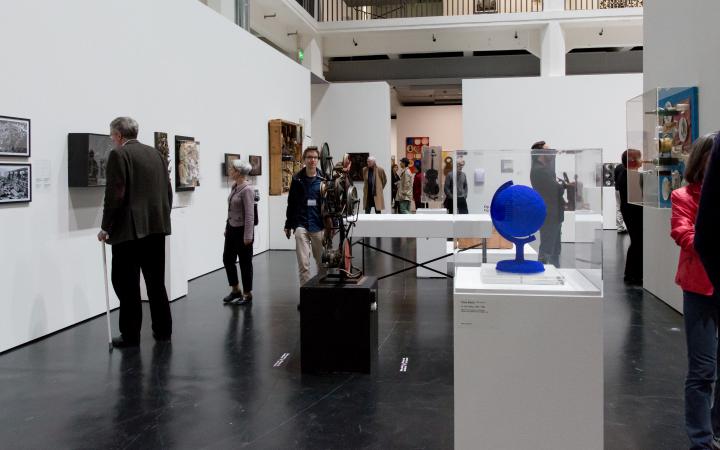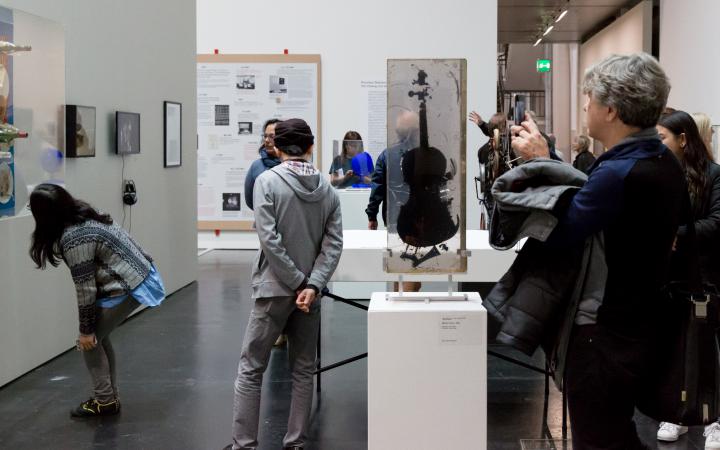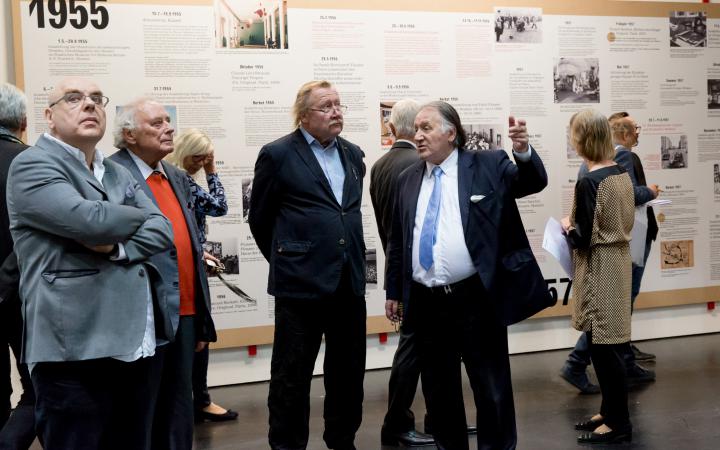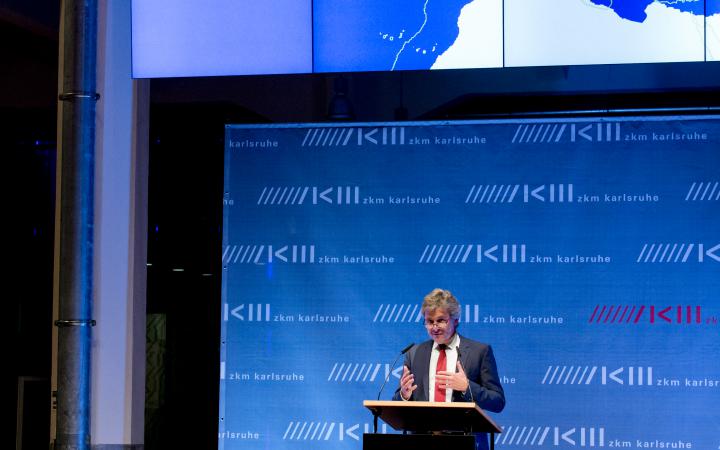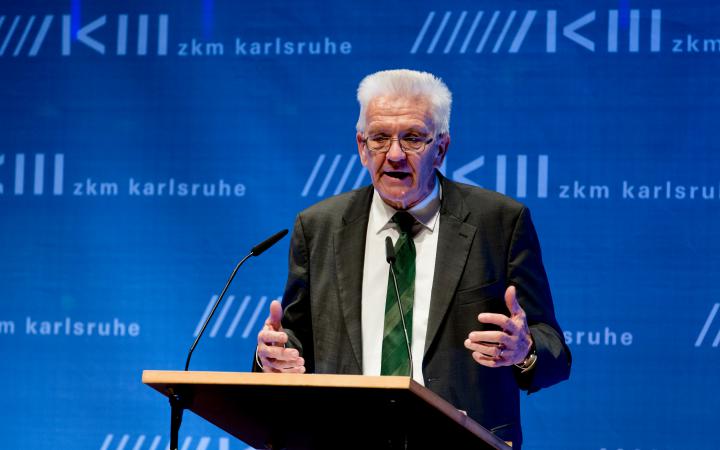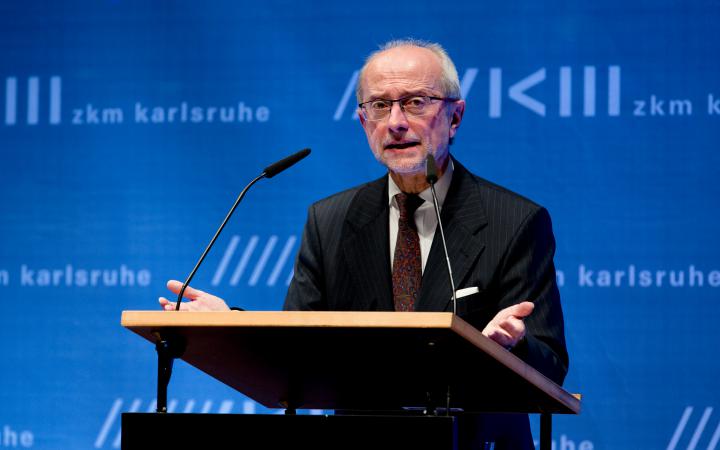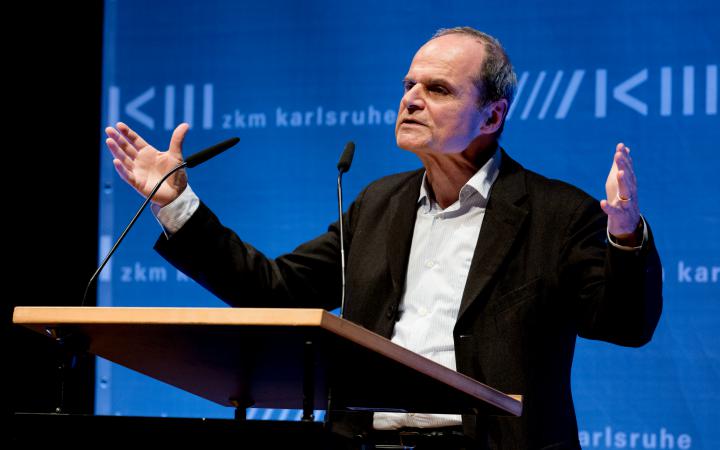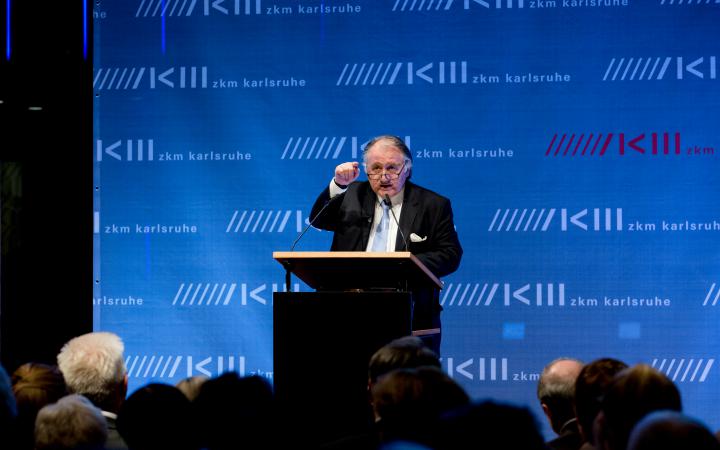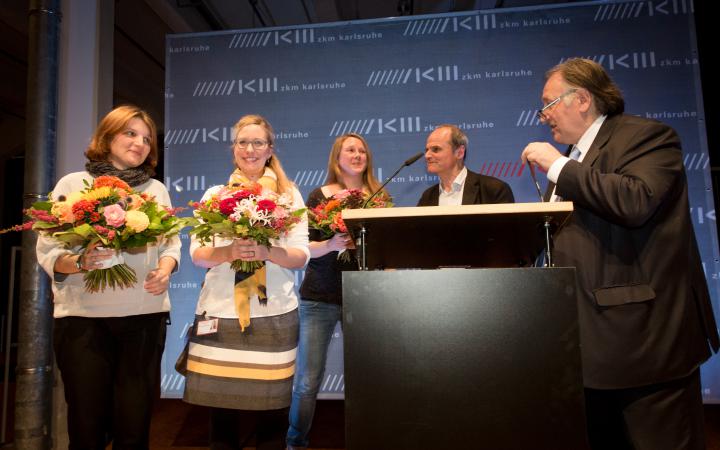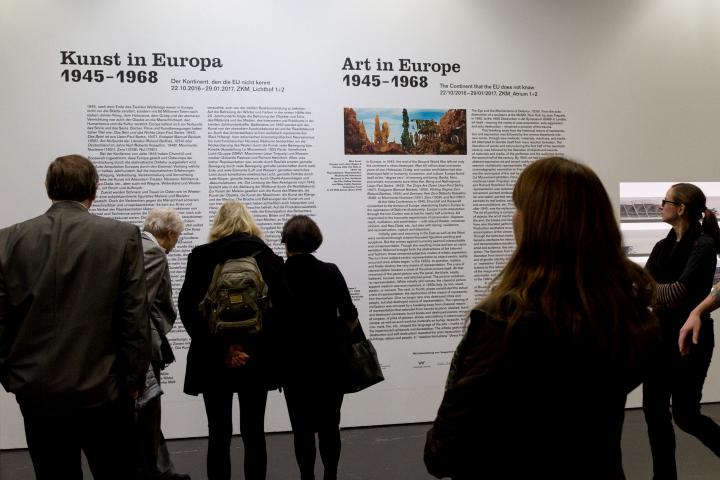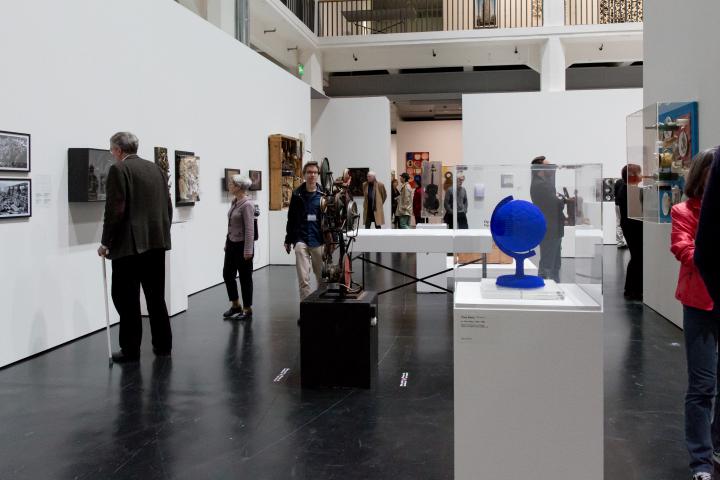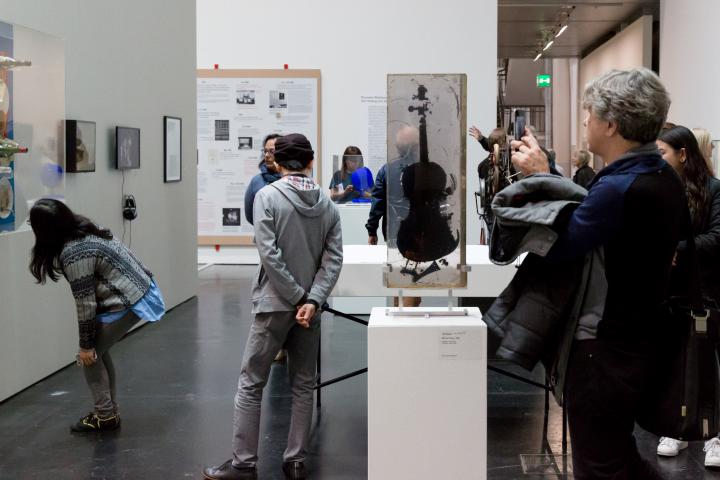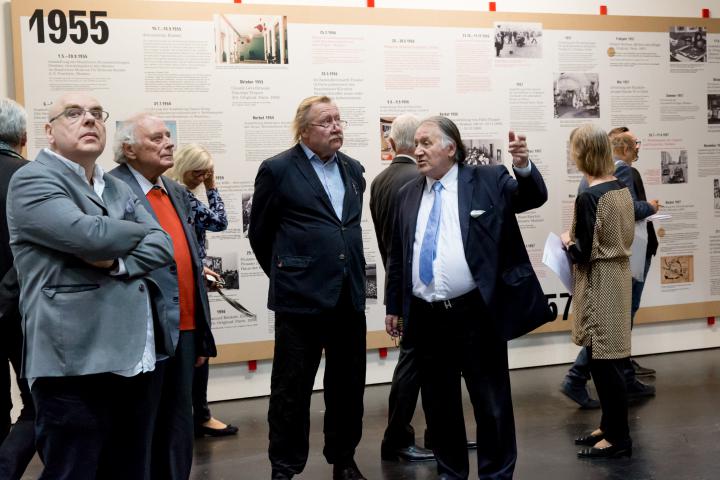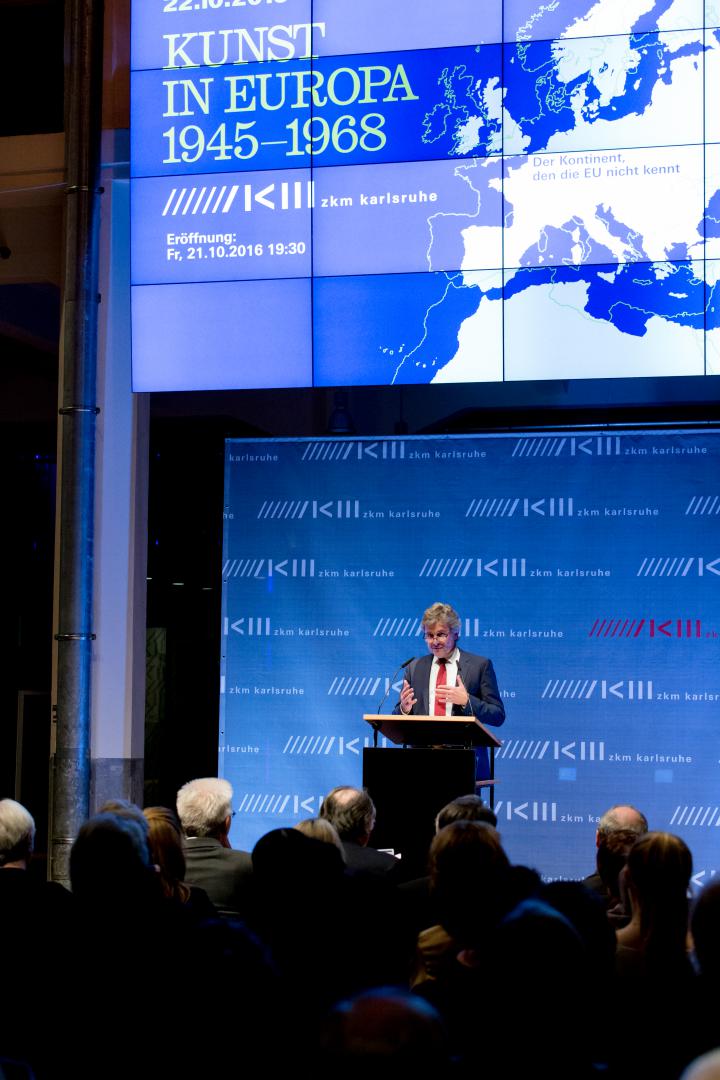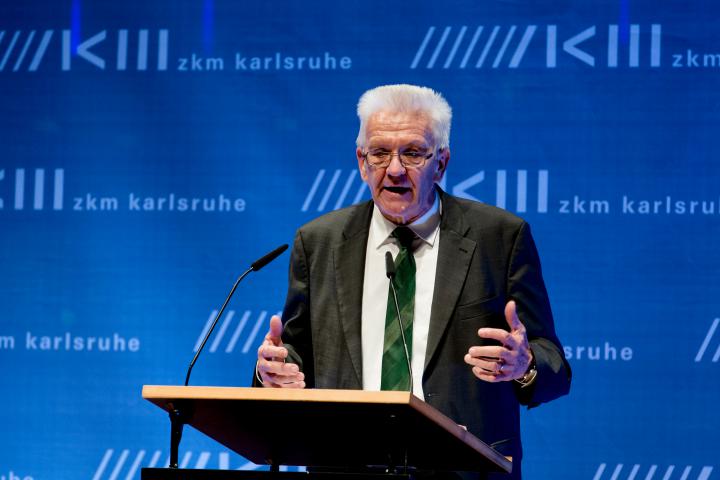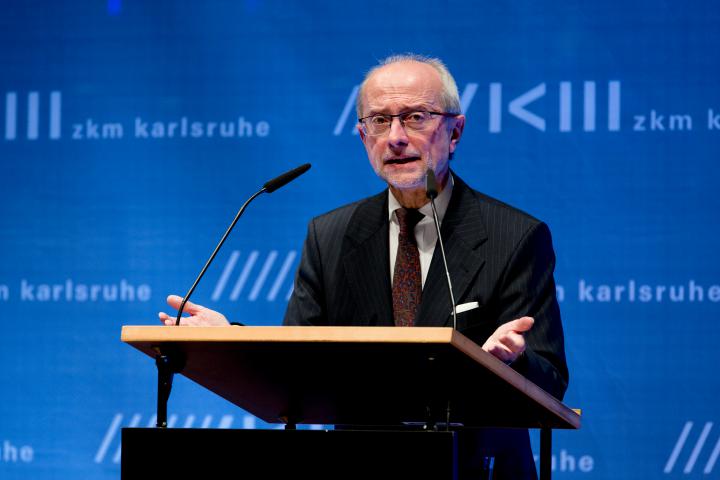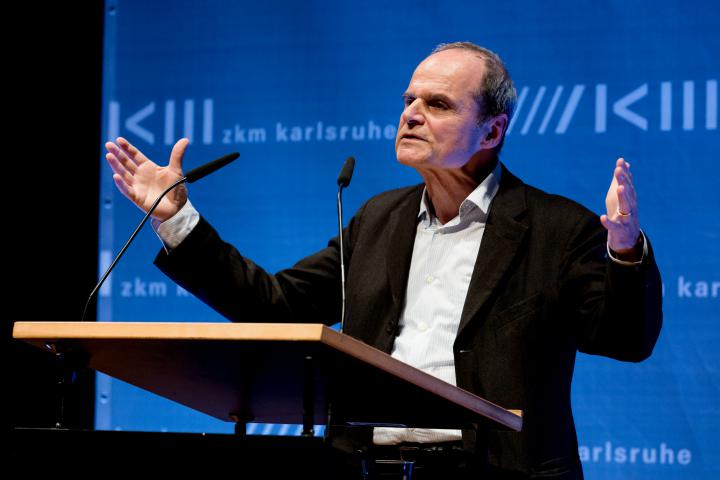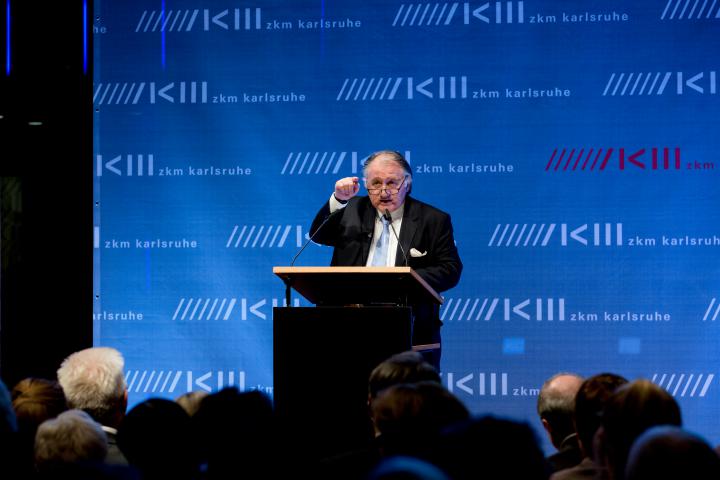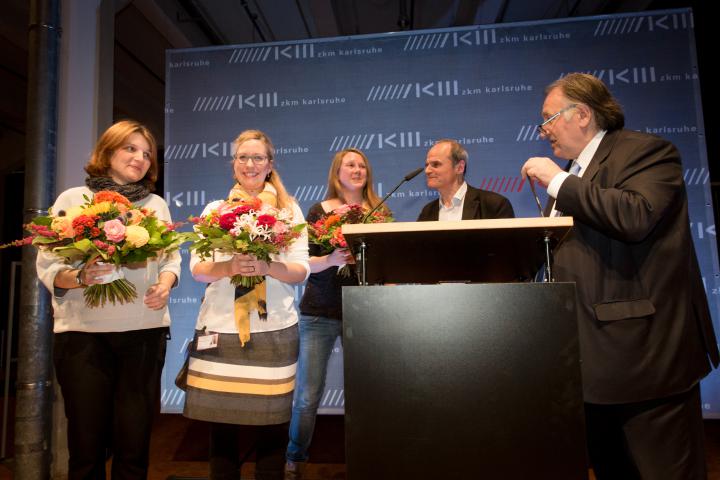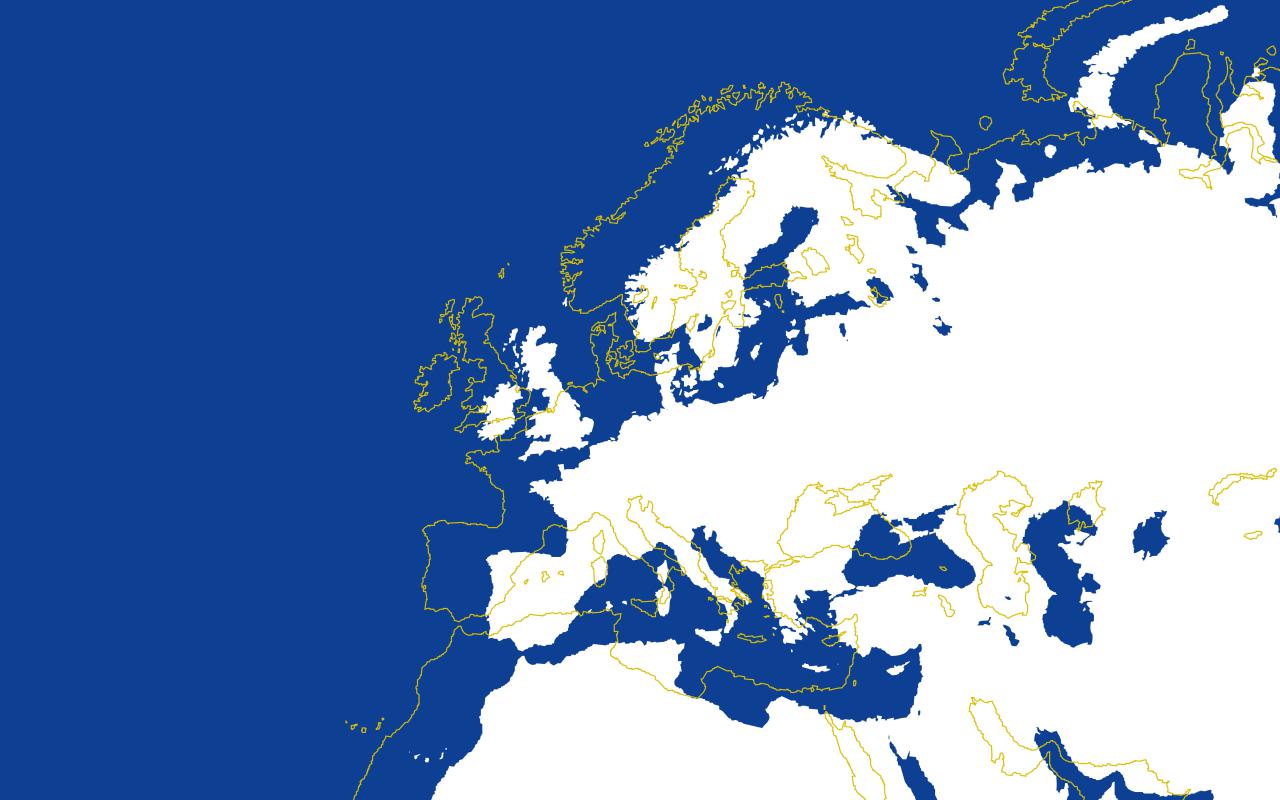
»The exhibition offers a new look at the cultural connections and historical links between the European nations. Through the historical retrospect, it opens up new perspectives to a future Europe and shows what a strong and positive effect art and culture can have to overcome the current crisis.«
– Winfried Kretschmann
Together with the A. S. Puschkin-Museum, the ROSIZO in Moscow and the BOZAR in Brussels, the ZKM is organising the large-scale exhibition project entitled »Art in Europe 1945-1968: Facing the Future« – curated by Eckhart Gillen and Peter Weibel. The exhibition focuses on the connecting cultural forces on the Eurasian continent and takes into account a central cultural region, which has been repeatedly shattered and disrupted by wars and crises in the 20th century. The period of 1945 to 1968, which is highlighted in the exhibition, stands in many ways for artistic and political perspectives, which were forward-looking in contradictory ways. After the end of the Second World War in 1945, the political and cultural boundaries hardened increasingly, until a decisive turning point for shaping the future in European post-war history in the East and West was marked ultimately in 1968 through the Anti-American student revolts and the new Ostpolitik introduced by Willy Brandt.
For the first time since 1945, the concept of retrospectively tracing the history of art in the whole of Europe can now be realised. To date, the attention of historiography was largely focussed on abstract expressionism as a symbolisation of the free West, while the socialist realism embodied the conservatism of the Communist East. But today, we know that this dominant model of art history was a product of the Cold War. For this reason, the exhibition attempts to reinterpret the development of art in Europe from a pan-European perspective and accounts for a specific renaissance of European art and culture in the period of 1945 to 1968. Whilst the exhibition project brings together the neo avant-garde from the East and West, it becomes evident that many new art forms (produced after the war) – from media art to conceptual art, from performance art to sound art – originated in Europe or were formulated simultaneously in Western Europe, the USA, Russia and Eastern Europe in parallel developments.
With the collaborative efforts of three internationally-renowned museums, the exhibition unites approx. 500 loans from over 200 artists into a panorama of pan-European art development on both sides of the historic Iron Curtain.
At the ZKM, which is focussing on the experimental artistic developments of the 1950s and 1960s in one of its programme lines, the exhibition is experiencing independent prioritisation and expansion. Representatives of Western neo avant-garde – like the ZERO group – are now appearing at the ZKM for the first time in the context of new Eastern European and Russian trends that have developed in parallel – such as the Nove Tendencije and the Dvizhenie group.
A new narrative about Europe is developing with the exhibition and the catalogue accompanying it. The separation of Europe as a result of the Yalta Conference in 1945 and the resulting Cold War gravely impacted on both Eastern Europe and Western Europe. The fact that Western Europe accepted this separation until the fall of the Berlin Wall in 1989 amounts to auto-amputation. The exhibition aims to retrospectively bring closer together what grew apart and became distanced during the time of divided Europe and thus further suture the gaping cultural wound that still exists between Eastern and Western Europe. The image of this »suture« itself can be documented multiple times in the artistic manifestations from the time between 1945 and 1968.
This reunification of Eastern and Western Europe, as put into place by the exhibition in the name of art, not only closes a gap within art history. It should also be taken as an active pleading for Europe – to face the future. The exhibition contrasts the current economic and political accounts, which are propelling Europe towards the right and back into the former nationalism, with a committed, alternative narrative. It is the task of art to show alternatives and facilitate change.
»If Armando’s painting of a black head is replaced by a black board with barbed wire and eventually with scorched objects, this is a captivatingly linear rationale. (...) The ZKM in Karlsruhe celebrates the healing power of art.«
– Ursula Scheer, in: Frankfurter Allgemeine Woche, 50/2016
»The Karlsruhe exhibition prepares nothing less than a mental map of manifests and artistic factions all occurring at almost the same time (...). From an artistic surrounding, which directly involves realities and visitors, machine-controlled movement and illuminations arise, which you can take – in the ZKM – as building blocks for media art.«
– Andrea Gnam, in: Neue Zürcher Zeitung, 31.12.2016
Artists
Marc Adrian, Yaacov Agam, Kurd Alsleben, Gábor Altorjay, Hans Peter Alvermann, Eric Andersen, Giovanni Anselmo, Marina Apollonio, Karel Appel, ARCHIGRAM, Arman, Armando, Art & Language, Roy Ascott, Enrico Baj, Vojin Bakić, Mario Ballocco, Paolo Baratella, Gianfranco Baruchello, Georg Baselitz, Max Beckmann, Otto Beckmann, Alfred Graßl, Joseph Beuys, Remo Bianco, Alberto Biasi (Gruppo N), Ely Bielutin, Max Bill, Hans Bischoffshausen, Agostino Bonalumi, Davide Boriani (Gruppo T), Václav Boštík, Van den, Guy Branden, Robert Breer, Jacques Brissot, Bazon Brock, Marcel Broodthaers, Günter Brus, Tadeusz Brzozowski, Bernard Buffet, Erik Bulatov, Daniel Buren, Victor Burgin, Alberto Burri, Hal Busse, Reg Butler, Pier Paolo Calzolari, Anthony Caro, Enrico Castellani, Jorge Castillo, Karel Černý, Ennio Chiggio, Christo, Inge Claus-Jansen, Ettore Colla, Compos 68, Constant, COOP HIMMELB(L)AU, Fritz Cremer, Roberto Crippa, Almir da Silva Mavignier, Dadamaino, Hanne Darboven, Gabriele de Vecchi (Gruppo T), Herman De Vries, Guy Debord, Alexander Deineka, Hugo Demartini, Gérard Deschamps, Bruno di Bello, Lucia di Luciano, Braco Dimitrijević, Milan Dobeš, Piero Dorazio, Gianni Dova, Jean Dubuffet, François Dufrêne, Umberto Eco, Equipo 57, Equipo Realidad, Miklós Erdély, EXAT 51, Valie Export, Agenore Fabbri, Luciano Fabro, Öyvind Fahlström, Harun Farocki, Jean Fautrier, Stano Filko, Robert Filliou, Constantin Flondor, Piero Fogliati, Lucio Fontana, Lucian Freud, Krisztián Frey, Bulat Galeyev und Prometheus-Büro, Ivo Gattin, Poul Gernes, Karl Gerstner, Stefan Gierowski, Hermann Goepfert, Gorgona Group, Zbigniew Gostomski, Tomislav Gotovac, Karl Otto Götz, Lily Greenham, HAP Grieshaber, Franco Grignani, Groupe de recherche d’art visuel, Hans Grundig, Milan Grygar, Renato Guttuso, Hans Haacke, Dieter Hacker, Raymond Hains, Matjaž Hanžek, Haus-Rucker-Co., Bernhard Heiliger, Wilhelm Hein, Jan Henderikse, Maurice Henry, Eva Hesse, Gerhard Hoehme, Oskar Holweck, Miljenko Horvat, HP Zimmer, Alfred Hrdlicka, Francisco Infante-Arana, Isidore Isou, Asger Jorn, Nam June Paik, Ilya Kabakov, Tadeusz Kantor, Lajos Kassák, Ilona Keserü, Yves Klein, Julije Knifer, Milan Knížák, Viacheslav Koleichuk, Július Koller, Béla Kondor, Gyula Konkoly, Arthur Køpcke, Dezső Korniss, Edward Krasiński, Dmitry Krasnopevtsev, Radoslav Kratina, Kurt Kren, Norbert Kricke, Vlado Kristl, Erkki Kurenniemi, László Lakner, Edoardo Landi (Gruppo N), Carl Laszlo, John Latham, Le Corbusier, Julio Le Parc, Jean-Jacques Lebel, Fernand Léger, Maurice Lemaître, Alfred Lenica, Adolf Luther, Heinz Mack, Karel Malich, Frank Josef Malina, Mangelos, Edgardo Mannucci, Piero Manzoni, Gerhard Marcks, Adam Marczyński, Enzo Mari, Gino Marotta, Manfredo Massironi (Gruppo N), Lidia Masterkova, Almir Mavignier, Hans Mayer-Foreyt, David Medalla, Christian Megert, Teresa Mellerowicz-Gella, Albert Mertz, Mario Merz, Gustav Metzger, Harald Metzkes, Manuel Millares, Henry Moore, Marcello Morandini, François Morellet, Tony Morgan, Gabriele Mucchi, Otto Muehl, Bruno Munari, Frieder Nake, Paul Nash, Georg Nees, Ernst Neizvestny, Werner Nekes, Hermann Nitsch, Jerzy Nowosielski, Marek Oberländer, OHO, Roman Opalka, Meret Oppenheim, Nam June Paik, Mihovil Pansini, Eduardo Paolozzi, Ervin Pátkai, Henk Peeters, A.R. Penck, Vladimir Petek, Pablo Picasso, Ivan Picelj, Otto Piene, Pierluca, Yuri Pimenov, Michelangelo Pistoletto, Dmitri Plavinsky, Stanislav Podhrázský, Marko Pogačnik, Uli Pohl, Sigmar Polke, Giò Pomodoro, Viktor Popkov, Charlotte Posenenske, Enrico Prampolini, Heimrad Prem, Oskar Rabin, Andrea Raccagni, Carol Rama, Jean-Pierre Raynaud, Martial Raysse, Antonio Recalcati, Alain Resnais, Gerhard Richter, Hans Richter, Bridget Riley, Jean-Paul Riopelle, Peter Roehr, Mikhail Roginsky, Mimmo Rotella, Dieter Roth, Georges Rouault, Roland Sabatier, Zorka Ságlová, Hans Salentin, Beatrice Sandomirskaya, Jean-Michel Sanejouand, Antonio Saura, Paolo Scheggi, Alfons Schilling, Niklaus Schilling, Tomas Schmit, Nicolas Schöffer, Eugen Schönebeck, Jan Schoonhoven, Emil Schumacher, Duro Seder, Vadim Sidur, Willi Sitte, Zdeněk Sklenář, Kjartan Slettemark, Ed Sommer, Jesús Rafael Soto, Karel Souček, Daniel Spoerri, Aleksandar Srnec, Klaus Staudt, Graham Sutherland, Zdeněk Sýkora, Alina Szapocznikow, Tamás Szentjóby, Takis, Paul Talman, Antoni Tàpies, Vladimir Tatlin, Hervé Télémaque, Gyarmathy Tihamér, Joe Tilson, Jean Tinguely, Endre Tót, Werner Tübke, Günther Uecker, Timm Ulrichs, Giuseppe Uncini, Jiří Valoch, Paul van Hoeydonck, Josip Vaništa, Grazia Varisco (Gruppo T), Victor Vasarely, Ben Vautier, Emilio Vedova, Vladimir Veisberg, Aleš Veselý, Nanda Vigo, Jacques Villeglé, Tibor Vilt, Daniela Vinopalová, Gerhard von Graevenitz, Vostell Vostell, Franz Erhard Walther, Peter Weiss, Ludwig Wilding, Stephen Willats, Gerd Winkler, Gil J. Wolman, Andrzej Wróblewski, Vladimir Yankilevsky, José Maria Yturralde, Yvaral, Rimma Zanevskaya, Herbert Zangs, Alexander Zhdanov, Yuri Zlotnikov und Gilberto Zorio.
- Exhibition team
Peter Weibel (Curator), Eckhart J. Gillen (Curator), in collaboration with Daria Mille (Co-Curatorin) und Daniel Bulatov (Co-Curator)
Judith Bihr (Project management), Daria Mille (Project management), Henrike Mall (Technical project management), Anett Holzheid (Research assistance), Margit Rosen (Research assistance), Marianne Meister (Logistics), Nina Fernandez (Logistics)
- Organization / Institution
- ZKM | Zentrum für Kunst und Medien Karlrsuhe
Accompanying program
-
- Tue, March 07, 2017
- Facing the Future
-
Staatliches Museum für Bildende Künste A. S. Puschkin, Moskau
-
- Sat, January 28, 20176 pm
- Exhibition Closing: Art in Europe 1945–1968
-
Finissage
Medientheater
-
- Sat, January 14, 20171 pm
- Tanze, Europa!
-
Workshop
ZKM | Zentrum für Kunst und Medien
-
- Sat, December 17, 20163.30 pm
- Kreatives schreiben
-
Workshop
Lichthof 1+2
-
- Fri, December 02, 20165 pm
- Guided tour with the curator through the exhibition »Art in Europe 1945–1968«
-
Guided Tour
Lichthof 1+2
-
- Thu, November 17, 20166.30 pm
- Art in Europe 1945–1968 | Author reading with Els Moors, Maarten van der Graaff and Peter Verhelst.
-
Reading
Kubus
-
- Thu, November 10, 20165 pm
- Kuratorenführung durch »Kunst in Europa 1945–1968«
-
Guided Tour
Lichthof 1+2
-
- Fri, November 04, 20164 pm
- Transgressions - Church at the ZKM
-
Guided Tour
Lichthof 1+2
-
- Fri, October 21, 20167.30 pm
- Exhibition Opening: Art in Europe 1945–1968
-
Opening
Foyer



